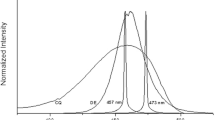Abstract
The applicability of diode-pumped solid state (DPSS) laser for light curing the composite resins was tested with a quartz–tungsten–halogen lamp-based unit and a light emitting diode unit. The emission spectra of the light-curing systems used match with the absorption spectrum of camphorquinone. Among the light-curing systems, DPSS laser showed the narrowest emission bandwidth. The light intensity of DPSS laser was approximately 64% of the other two light-curing units. In most specimens, DPSS laser showed the least attenuation of the number of incident photons. On the top surface, specimens cured with DPSS laser showed similar microhardness values compared to the specimens cured with the other two light-curing units. During the light curing, DPSS laser induced the lowest temperature rise (25.5 ∼ 35.5°C) in the specimens compared to the other two light-curing units (34.2 ∼ 41.7°C). In conclusion, DPSS laser has high potential to be an alternative to the other light-curing units or a new light-curing unit.



Similar content being viewed by others
References
Hofmann N, Hugo B, Klaiber B (2002) Effect of irradiation type (LED or QTH) on photo-activated composite shrinkage strain kinetics, temperature rise, and hardness. Eur J Oral Sci 110:471–479
Pradhan RD, Melikechi N, Eichmiller F (2002) The effect of irradiation wavelength bandwidth and spot size on the scra** depth and temperature rise in composite exposed to an argon laser or a conventional quartz–tungsten–halogen source. Dent Mater 18:221–226
Soares LE, Martin AA, Pinheiro AL, Pacheco MT (2004) Vickers hardness and Raman spectroscopy evaluation of a dental composite cured by an argon laser and a halogen lamp. J Biomed Opt 9:601–608
Asmussen E, Peutzfeldt A (2005) Temperature rise induced by some light emitting diode and quartz-tungsten-halogen curing units. Eur J Oral Sci 113:96–98
Bouillaguet S, Caillot G, Forchelet J, Cattani-Lorente M, Wataha JC, Krejci I (2005) Thermal risks from LED-and high-intensity QTH-curing units during polymerization of dental resins. J Biomed Mater Res B Appl Biomater 72B:260–267
Oberholzer TG, Du Preez IC, Kidd M (2005) Effect of LED curing on the microleakage, shear bond strength and surface hardness of a resin based composite restoration. Biomaterials 26:3981–3986
Kelsey WP, Blankenau RJ, Powell GL, Barkmeier WW, Stormberg EF (1992) Power and time requirements for use of the argon laser to polymerize composite resins. J Clin Laser Med Surg 10:273–278
Telford W, Murga M, Hawley T, Hawley R, Packard B, Komoriya A, Haas F, Hubert C (2005) DPSS yellow-green 561-nm lasers for improved fluorochrome detection by flow cytometry. Cytometry 68A:36–44
Vargas M, Cobb DS, Schmit JL (1998) Polymerization of composite resins: argon laser vs conventional light. Oper Dent 23:87–93
Rueggeberg FA, Ergle JW, Mettenburg DJ (2000) Polymerization depths of contemporary light-curing units using microhardness. J Esthet Dent 12:340–349
Lovell LG, Lu H, Elliott JE, Stansbury JW, Bowman CN (2001) The effect of cure rate on the mechanical properties on dental resins. Dent Mater 17:504–511
Zach L, Cohen G (1965) Pulpal response to externally applied heat. Oral Surg Oral Med Oral Pathol 19:515–530
Hussey DL, Biagioni PA, Lamey PJ (1995) Thermographic measurement of temperature change during resin composite polymerization in vitro. J Dent 23:267–271
Taira M, Urabe H, Hirose T, Wakasa K, Yamaki M (1988) Analysis of photo-initiators in visible-light-cured dental composite resins. J Dent Res 67:24–28
Hinoura K, Akiyama Y, Miyazaki M, Kuroda T, Onose H (1995) Influence of irradiation sequence on dentin bond of resin inlays. Oper Dent 20:30–33
Bouschlicher MR, Rueggeberg FA, Boyer DB (2000) Effect of stepped light intensity on polymerization force and conversion in a photoactivated composite. J Esthet Dent 12:23–32
Boyer DB, Chalkley Y, Chan KC (1982) Correlation between strength of bonding to enamel and mechanical properties of dental composites. J Biomed Mater Res 16:775–783
Kwon YH, Kwon TY, Ong JL, Kim KH (2002) Light-polymerized compomers: coefficient of thermal expansion and microhardness. J Prosthet Dent 88:396–401
Raab WH (1992) Temperature related changes in pulpal microcirculation. Proc Finn Dent Soc 81:469–479
Noda M, Wataha JC, Kaga M, Lockwood PE, Volkmann KR, Sano H (2002) Components of dentinal adhesives modulated heat shock protein 72 expression in heat-stressed THP-1 human monocytes as sublethal concentrations. J Dent Res 81:265–269
Wataha JC, Lewis JB, Lockwood PE, Hsu S, Messer RL, Rueggeberg FA, Bouillaguet S (2004) Blue light differentially modulates cell survival and growth. J Dent Res 83:104–108
Acknowledgements
This study was supported by Medical Research Institute Grant (2005-45), Pusan National University.
Author information
Authors and Affiliations
Corresponding author
Rights and permissions
About this article
Cite this article
Kwon, Y.H., Jang, CM., Shin, DH. et al. The applicability of DPSS laser for light curing of composite resins. Lasers Med Sci 23, 407–414 (2008). https://doi.org/10.1007/s10103-007-0496-0
Received:
Accepted:
Published:
Issue Date:
DOI: https://doi.org/10.1007/s10103-007-0496-0




